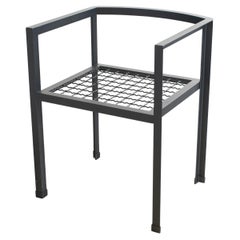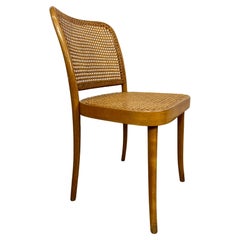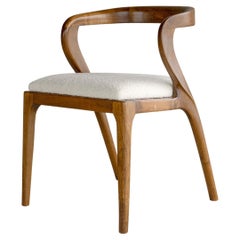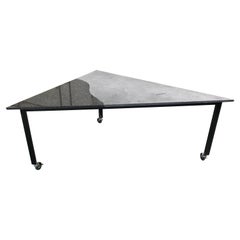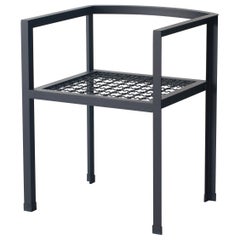Rei Kawakubo Furniture
Comme des Garçons is one of the world’s most innovative and trailblazing fashion brands, helmed by its inimitable founder, Japanese designer Rei Kawakubo (b. 1942), who has a penchant for breaking fashion and cultural norms.
Perhaps no designer better embodies fashion cool than Kawakubo. And when she makes industry veterans lose their cool, well, that’s a fashion moment. The only living designer apart from Yves Saint Laurent to have a retrospective at the Metropolitan Museum of Art’s Costume Institute, Kawakubo has permanently changed fashion — her designs for widely loved vintage Comme des Garçons dresses, shirts and other clothing and accessories challenge traditional ideas of beauty with a creative and transgressive exuberance.
After studying art and literature at Keio University in Tokyo, Kawakubo worked as a freelance stylist before establishing her own label in 1969. Comme des Garçons — which is also known as CDG — officially launched in 1973, and Kawakubo opened her first store in Tokyo three years later. She has since been instrumental in pioneering many concepts now familiar in contemporary fashion.
One of Kawakubo’s most iconic moves was her introduction of androgynous styles (Comme des Garçons means “like the boys” in French) with asymmetrical, twisted silhouettes that envelope the body. While she told the New York Times that the “basics of clothing lie in men’s fashion,” Kawakubo believes in the concept of humanness in clothes (she titled her spring 1995 show “Transcending Gender”). In the 1970s, when color-blocking was the norm, Kawakubo stuck to her monochromatic color palette dominated by shades of black with uncompromising dedication, although with evocative and powerful use of red and white.
Comme des Garçons is also known for an often shocking take on fashion. Deconstructed tailoring, violently slashed fabric and sculptural shapes are some themes that run through the brand’s collections, but Kawakubo never explains the meaning of her conceptual pieces, which fall somewhere between art and fashion. For Kawakubo, the body is a mere support, an easel that holds the canvas on which she exercises her formidable creative energy in a perpetual quest to invent a brave new world using fabric, or its equivalent, as her brushstroke. Today's enthusiasts of 1990s fashion revere Kawakubo for her progressive pink plaid grunge dresses, velvet jackets and nylon skirts of the era, which resembled little else back then. They were modeled by the likes of Naomi Campbell and other luminaries of the industry.
Even though the brand has over the years worked with other innovative designers such as Tao Kurihara and Junya Watanabe and has launched more commercial offshoots like PLAY, known by the iconic heart motif with eyes, the premier men’s line Homme Plus and the multilabel Dover Street Market that opened in 2004, the essence of Comme des Garçons remains Kawakubo’s otherworldly and undefinable creations, which are impossible to ignore.
Find vintage Rei Kawakubo shirts, jackets, day dresses and other clothing on 1stDibs.
1980s Japanese Minimalist Vintage Rei Kawakubo Furniture
Steel
1930s Czech Bauhaus Vintage Rei Kawakubo Furniture
Rattan, Beech, Bentwood
21st Century and Contemporary Turkish Modern Rei Kawakubo Furniture
Upholstery, Foam, Beech
21st Century and Contemporary Turkish Modern Rei Kawakubo Furniture
Upholstery, Foam, Walnut
Early 1900s Austrian Vienna Secession Antique Rei Kawakubo Furniture
Beech, Bentwood
2010s Mexican Mid-Century Modern Rei Kawakubo Furniture
Leather, Fabric, Walnut
1990s Italian Post-Modern Rei Kawakubo Furniture
Wood
Early 1900s Czech Vienna Secession Antique Rei Kawakubo Furniture
Rattan, Bentwood
Early 1900s Austrian Vienna Secession Antique Rei Kawakubo Furniture
Beech, Bentwood
1970s Slovenian Mid-Century Modern Vintage Rei Kawakubo Furniture
Cane, Hardwood, Bentwood
1980s Hungarian Jugendstil Vintage Rei Kawakubo Furniture
Fabric, Bentwood
1990s Italian Post-Modern Rei Kawakubo Furniture
Wood
Late 18th Century Austrian Art Nouveau Antique Rei Kawakubo Furniture
Upholstery, Wood, Fabric
Late 20th Century Japanese Modern Rei Kawakubo Furniture
Granite, Steel
1980s Japanese Minimalist Vintage Rei Kawakubo Furniture
Steel
1980s Japanese Minimalist Vintage Rei Kawakubo Furniture
Steel
Late 20th Century Italian Post-Modern Rei Kawakubo Furniture
Granite, Steel
1980s Japanese Minimalist Vintage Rei Kawakubo Furniture
Steel
1980s Vintage Rei Kawakubo Furniture
1980s Japanese Post-Modern Vintage Rei Kawakubo Furniture
Steel
1980s Japanese Post-Modern Vintage Rei Kawakubo Furniture
Steel
1980s Japanese Post-Modern Vintage Rei Kawakubo Furniture
Cut Steel
1980s Japanese Post-Modern Vintage Rei Kawakubo Furniture
Steel
Late 20th Century Italian Rei Kawakubo Furniture
Granite, Iron
